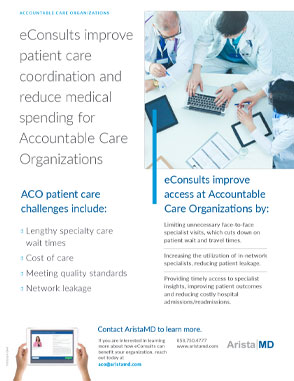Tools for ACOs and population health
Implementing eConsults provides ACOs and population health benefits across numerous cases. At any referring clinic: Treat more patients without a referral, ensure PCPs and specialists are operating at top-of-license, increase patient satisfaction, and reduce network leakage.
Download our ACOs and population health brochure to learn more about how eConsults are an effective telehealth system for achieving patient care goals.

How VBC is Changing to Support ACOs and Population Health?
Value-based care is a trending topic and an industry buzzword. Value-based care payment models emphasize quality over quantity of care. Providers are rewarded for improving health outcomes and patient satisfaction.
While CMS and other payers incentivize primary care providers to raise the overall quality of care by rewarding providers for efficiency and efficacy, the programs offer a few actionable steps to make value-based care a reality.
How can a provider tangibly deliver better, more efficient, and more effective care?
Truly, the answer is as simple as eConsults. eConsults are proven to save patients money and reduce the cost of care for both providers and payers.
eConsults serve as a preventive measure in specialist backlogs and worsened health outcomes resulting from delayed patient care. Additionally, eConsults improve the accessibility of quality care to those in lower-income, rural and other underserved areas.
What is value-based care?
While almost everyone working in healthcare today is familiar with the phrase “Value-based Care”, it’s important to articulate a common definition.
In 2006, Michael Porter and Elizabeth Teisberg explained the value equation as: Value equals quality divided by cost. This definition of value-based care has evolved from the Porter-Teisberg definition to describe the payment model or form of reimbursement, which ties payment for care to the quality of care provided. This form of reimbursement has emerged as an alternative and potential replacement for fee-for-service reimbursement, which pays providers retrospectively for services delivered based on bill charges or annual fee schedules.

